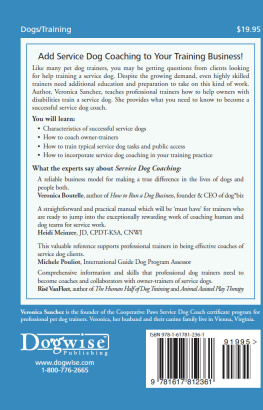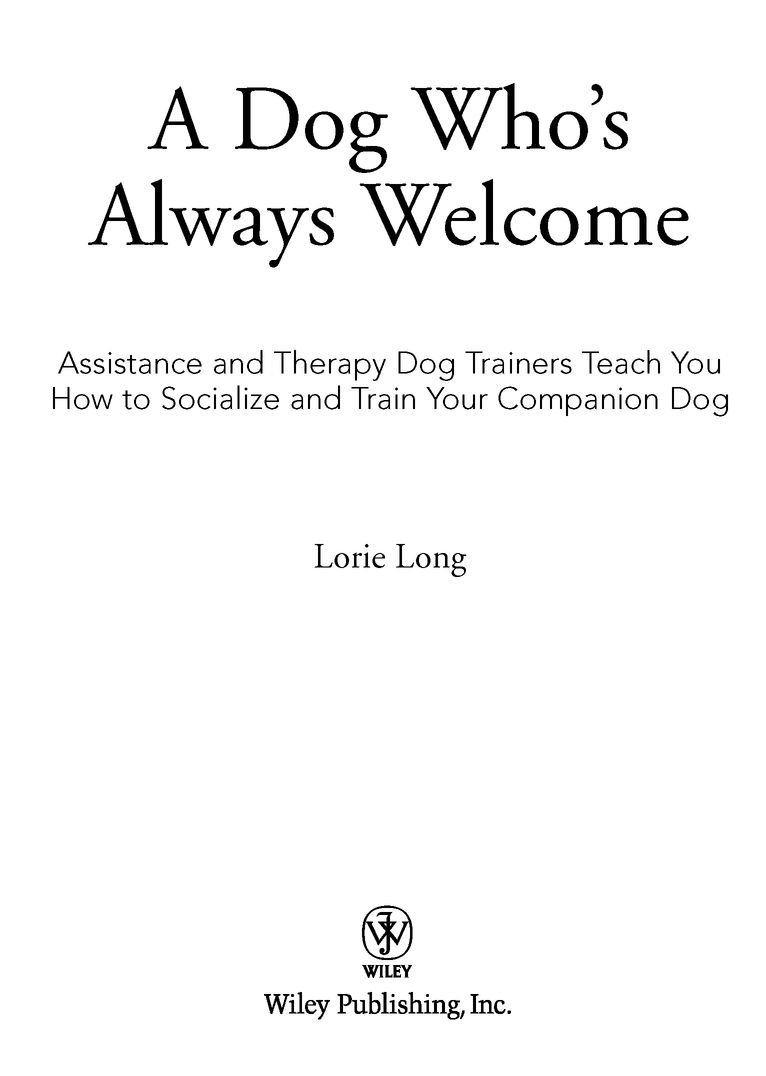Table of Contents
To the dogs of my past:
You continue to walk by my side in spirit.
To the dogs of my present:
You bring a unique joy to every day.
To the dogs of my future:
You are my as yet undiscovered treasures.
I cant wait to meet you.
And, to my husband, Ralph, who gets it about
me and dogs.
Acknowledgments
For encouragement, insights, and answers to my endless questions, I extend my deepest thanks to Brian Jennings, Sheila OBrien, Lydia Wade-Driver, Danielle Moore, Marilyn Wilson, Elizabeth Broyles, Connie Knisely, Cabell Youell, Ann Hogg, Nancy Patriarco, Jan Stice, Jeanie Calhoun, Kali Kosch, Karen Hough, Linda Eaton, Maggie Blutreich, Elsa Larson, and the St. Francis puppy raisers. Dogs have no better friends than all of you.
For providing me with a map of how to bring a passion for ideas about dog training to print, I thank my agent, Kate Epstein.
For the gentle guidance and occasional tough love it took to make this book the best it could be, I thank my editor, Beth Adelman. You knew where we were going right from the start and you showed me the way. Thanks, Beth.
For enduring the travails of being married to a writer with a deadline, and for sticking it out to see how it all ended, I thank my husband, Ralph, a great doggie dad.
It takes two years and costs between $7,000 and $20,000 to acquire, raise, and train a highly skilled assistance dog. Many disabled recipients receive their canine partner free of charge. The training centers rely on charitable contributions to support their efforts. Please consider contributing to the following assistance dog training centers when you plan your charitable giving. You will give the gift of independence to a disabled person and the gift of honorable work to a good dog.
Thanks from all of us!
St. Francis of Assisi Service Dog Center
P.O. Box 19538
Roanoke, VA 24019
(540) 342-DOGS
www.stfrancisdogs.org
Blue Ridge Assistance Dogs, Inc.
P.O. Box 229
Manassas, VA 20108
(703) 369-5878
www.blueridgeassistancedogs.info
Assistance Dogs of America, Inc.
8806 State Route 64
Swanton, OH 43558
(419) 825-3622
www.adai.org
Introduction
The George Mason University campus is nestled on a grassy, tree-shaded wedge of land in Fairfax, Virginia, an upscale suburb of Washington, D.C. Surrounded by traffic-clogged streets, overbuilt bedroom communities, and a population of professionals, corporate executives, diplomats, and government employees, the school caters to a population of highly diverse commuter students.
During the late 1990s, I regularly sped from my nearby corporate office to this campus to attend evening courses. And, on most of those occasions, I encountered another student and her assistance dog, a beautiful Golden Retriever, on their way to her classes. Although she and I never attended the same classes, I watched them both on campus, through several semesters, with great interest. She and her dog fascinated me.
I had been training my own dogs and teaching canine obedience classes to the public, privately, and as a volunteer for a local dog training club, for more than twenty years. I had taught beginner through advanced students the skills and techniques they needed to mold and modify their dogs behaviors in a way that created an obedient family dog. I had even taught students how to train their dogs to compete in American Kennel Club obedience trials. Hundreds of dogs and owners had come through my classes and achieved various levels of success.
I instructed my beginner students about how to teach the commonly used good manners commands to their dogs, such as sit and down and stay and heel. At that time, most trainers still relied on the choke collar, strong verbal commands, an occasional treat, and repeated training drills to teach behaviors. The other club trainers and I spent a great deal of time teaching students how to work with their dogs, using these tools in a humane way.
Generally, though, I wanted the dog and owner teams graduating from my obedience classes to achieve a higher level of partnership. But I wasnt entirely sure what was missing from my training program. Some students did a fine job of using the training techniques, and their dogs reliably displayed the asked-for behaviors. However, other students could barely contain their dogs in class. These dogs rarely stopped lunging at other dogs or people in the class, constantly pulled on their leashes, whined or barked, dug in the dirt (we taught classes in a horse barn), barreled in and out of the car, and tripped their owners because they were always underfoot and in motion. Once in awhile, by the end of the session, these hard-to-handle dogs would sit or heel when signaled to do so; their owners complained that the dogs would obey their signals perfectly at home but would not honor their wishes or take direction in public.
Soon, positive reinforcement training techniques replaced the militaristic methods of choke collar corrections and punishment. Thankfully, these aversive styles of training were no longer the preferred methods of modifying dog behaviors. They were replaced by food rewards, play training, shaping desired dog behaviors in a positive way, and allowing undesirable behaviors to extinguish themselves by not rewarding them. The dogs in my classes learned behaviors faster and were happier using these positive training methods, and the owners felt better about the training process.
All the instructors advised their students to proof the training of dog behaviors. We told the students first to teach their dogs a behavior at home, such as down. Then, to proof the dogs ability to perform the behavior in public, we suggested that the students take their dogs to the park, or to a friends yard, or to the parking lot of the library, and practice the down command. Including proofing in my training program did produce some improvement in a dogs ability to perform away from her home training environment, but most students found it to be a long, tiresome, and frustrating process. Later, when I started learning from service dog trainers, they helped me understand what was missing from this approach.
Did the dogs in my classes become better overall companions or family members as a result of the change to more positive training methods and proofing? To some extent, yes. But I still heard complaints about how the dogs did not perform reliably in everyday life. What was still missing?
At the university, I watched the disabled students assistance dog exhibit an entirely different type of companion dog behavior. The student was confined to a wheelchair. Her dog reliably demonstrated behaviors such as picking up dropped items, giving money to the cashier in the student union coffee shop, walking next to the wheelchair without lunging no matter the speed of travel, pushing doors open, and lying down quietly when his owner paused. The dog acted with complete decorum while cars whistled past her in the parking lot, when a student dropped an armful of books only a few feet away, and when someone at a full run shouted from one end of a noisy corridor to the other right behind him. The dog commuted by car, walked through automatic doors, took the elevator, stood in many lines with his owner, and waited quietly while she ate her snack in the cafeteria.












